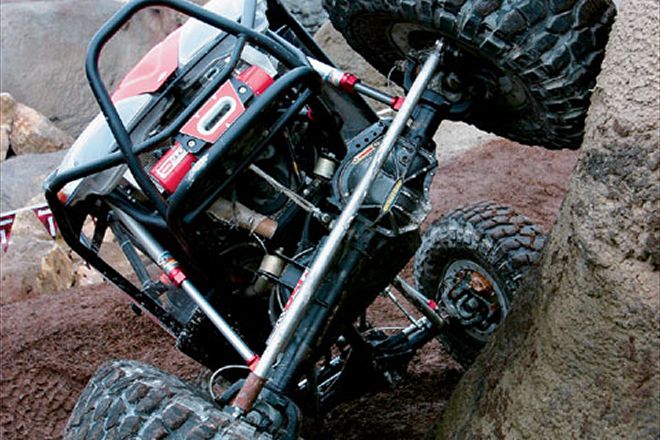
 Fred Williams
Brand Manager, Petersen’s 4Wheel & Off Road
Photographers:
Poly Performance
Fred Williams
Brand Manager, Petersen’s 4Wheel & Off Road
Photographers:
Poly Performance
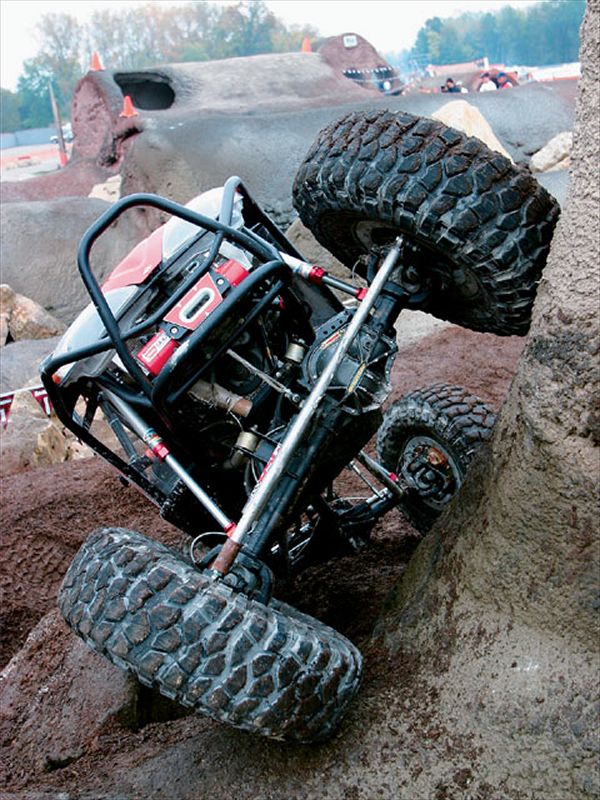
They are turning up everywhere we look these days. They look like shocks, but they are being used instead of springs; they're modern air shocks. We first saw them under a lightweight Suzuki-buggy-thing about five years back, but now every other competition rockcrawler and monster truck, plus tons of trail rigs are running these lightweight shocks between their frames and axles. But what exactly are they?
Air shocks are a compromise between a shock and a spring. They are very similar to nitrogen-charged emulsion shocks. However, you will quickly notice that air shocks have a much larger chrome shaft that runs out of the body. Now don't confuse these performance air shocks with the old load-carrying type found under fullsize trucks as well as some Joe Dirt musclecars. These new air shocks look very much like the coilover shocks used by desert racers and rockcrawlers, but without the coil springs around the outside of the shock body. What really makes folks scratch their head is that no other type of spring is used with air shocks-no coils, leaves, or airbags. The air shock itself works as both spring and shock in a cheap, lightweight, and simple package-but like a Swiss army knife of suspension, they are good enough to get it done, but not necessarily the best tool for the job.
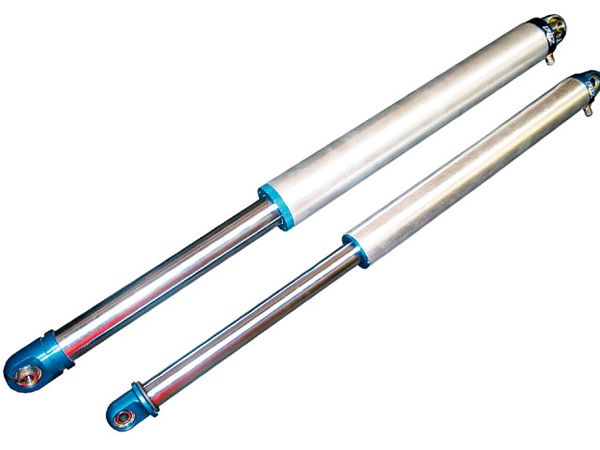
Cheap, Light, Cool
Currently at least five companies make air shocks (Sway-A-Way, Walker Evans Racing, Fox, King, and Rad-Flo), but the most prolific and one of the originators is Fox Racing Shox. In discussions with Dave Schlossberg of Poly Performance, we learned that air shocks are hot these days, and with good reason. Air shocks, when compared to coilover shocks and leaf-spring suspensions, have some very promising attributes. They are cheap, $225 to $350 each, depending on make and size (nearly half the cost of a coilover with coils), much lighter (6 to 18 pounds each), and when compared to an old set of leaf springs they are definitely cooler-looking. But how well do they work?
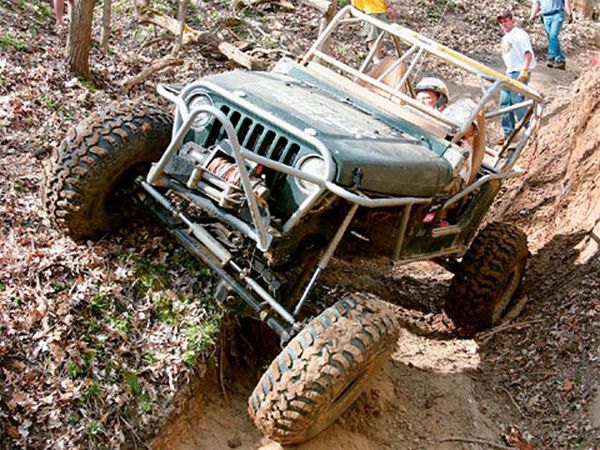
Link It Up
Before we discuss performance you must consider that an air shock, like a coil spring, air spring, or coilover shock, will need a link suspension under your 4x4 to effectively locate the axle. Proper design of the three- or four-link geometry is important to keep the axle from moving laterally, and fore and aft, while allowing it to articulate and travel up and down over trail obstacles. The angles, lengths, and mounting locations of the link suspension will also determine if the chassis jacks up or squats when power is applied to the tires and how the axles move under articulation. This is a topic we have addressed before (see 4-Link Tech in the tech/suspension section of our Web site www.4wheeloffroad.com), and requires a fair bit of experience to comprehend, much less master, so do the research before you build.
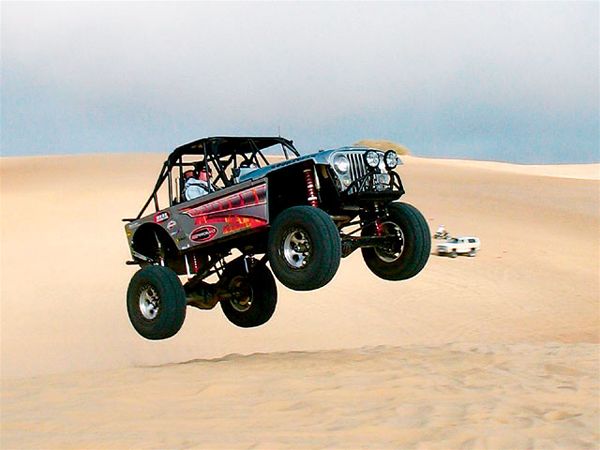
Floating Piston, Emulsion, And Air
So is an air shock just a big shock? Yes, but more. There are two different types of damping shocks: emulsion shocks where the body is charged with both nitrogen and oil in the same chamber, and floating-piston shocks where the oil is separated from the nitrogen charge with a floating piston (some shocks also have a remote reservoir that houses the floating piston). The damping of a shock is done when the oil within the shock body is forced through small holes in a piston at the end of the shock shaft as the suspension compresses or rebounds. A rebuildable shock, such as an air shock or coilover shock, allows disassembly and adjustment of those valves to achieve optimum damping. However, an emulsion shock offers inferior damping ability compared to a floating-piston design because as the piston moves up and down during high-speed off-roading it can quickly aerate the oil till it becomes a foamy mixture of oil and nitrogen bubbles within the shock body. When this happens the shock can lose a lot of its damping ability since it is passing both oil and nitrogen through the piston valves. Unfortunately an air shock is an emulsion shock but with a larger shaft, and there are currently no floating-piston air shocks on the market, mostly because the cost would be prohibitive.
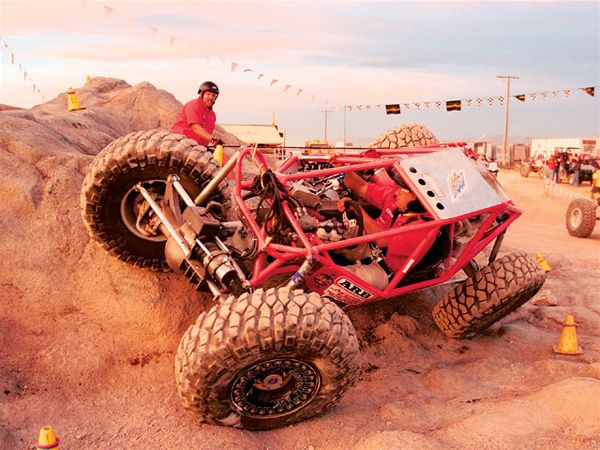 Yes
Yes
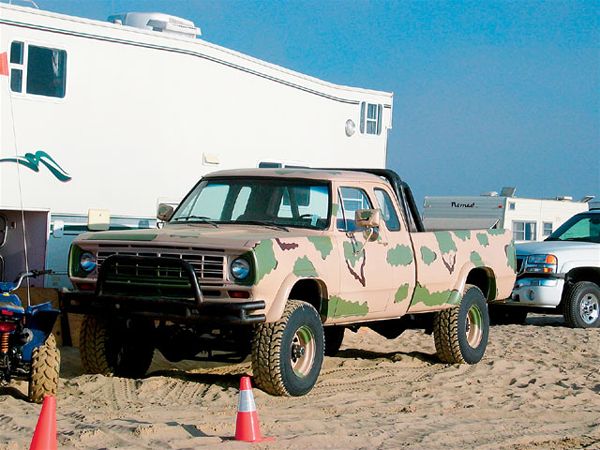 No
No
Appropriate Applications
Air shocks were originally designed for motorcycles and then modified to work on lightweight off-road buggies, though their weight ratings reveal that they can support a fair bit of load. The 2-inch-diameter version is rated to a maximum of 500 pounds per shock, or 2,000 pounds of sprung weight, however the 2 1/2-inch versions double that at 1,000 pounds each, so that's 4,000 pounds of sprung weight, enough for nearly any open-topped Jeep, mini-truck, and even some Blazers and Broncos (remember we are talking sprung weight; this does not include axles, tires, and wheels). However, once you start getting into the fullsize truck category, it's time to step up from air shocks. You may be wondering why monster trucks run air shocks; most of them also have a dampening shock, and for the price of those custom units you could have a quality coilover with coils that will work better, as we will explain.
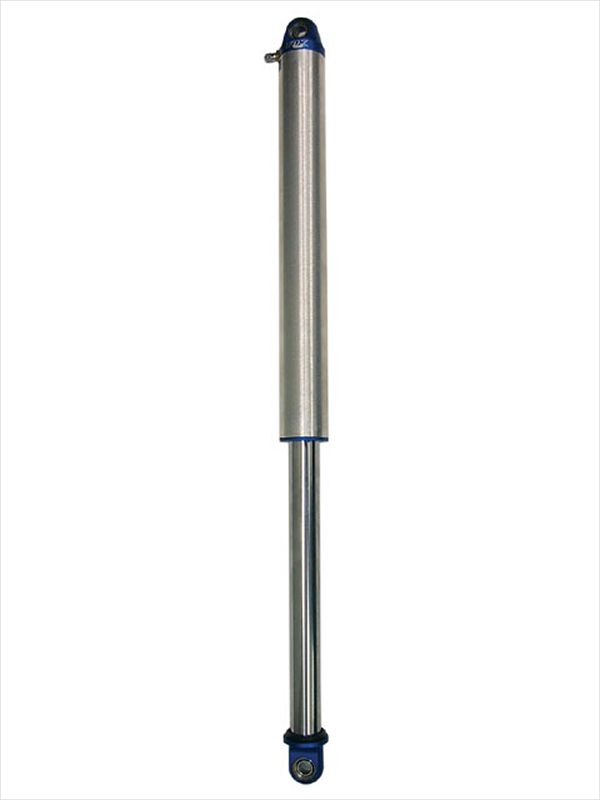
Spring Rate
The problems arise when the air shock tries to do two jobs at once-support the weight of the vehicle like a spring, and damping the movement of the suspension like a shock. The main reason for this is due to the spring rate of the air shock. On a basic coil- or leaf-spring the spring rate is a given amount (for examples sake, we'll say 100 pounds per inch), so to compress the spring 1 inch you need 100 pounds, then to go 2 inches you need another 100 pounds, adding up to 200 pounds and so on. With an air shock the spring rate is very flat for the majority of the compression and then near the end of its compression it ramps up quickly. For example, it may only go from 30 to 200 pounds for the first three-quarters of total compression, but then the final 4 inches will jump up to nearly 7,000 pounds (these numbers will change according to the nitrogen charge, but the general curve will stay the same). This results in a suspension that has little resistance to compression or rebound force for the first 60 to 75 percent of the shock's travel and then the final 30 percent gets exponentially harder to compress and quicker to rebound. This may seem like a great attribute, almost like having a bumpstop built into your air shock, but when this erratic spring rate is combined with the unpredictable damping of an emulsion shock, these magical mystery shocks don't look so wonderful anymore.
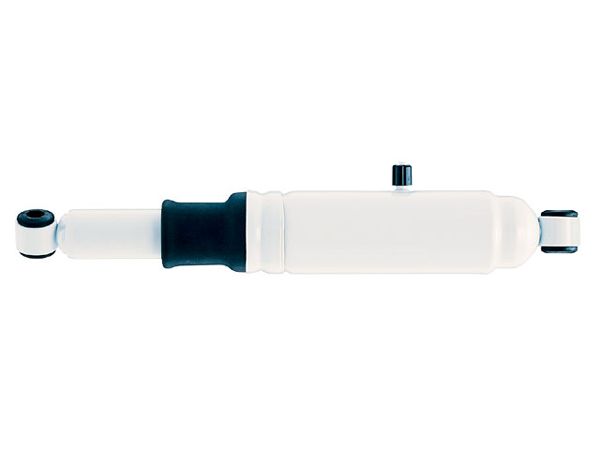
Old School Air
This story wouldn't be complete without mentioning load-carrying air shocks such as the Gabriel or Monroe air shock absorbers. These are designed as a supplemental overload spring, and work by adding air to an enclosed chamber much like the airbag overload springs. The benefit to this style air shock is it allows the use of a softer riding spring pack for your truck for off-road use, but then the shock can be aired up for your next trip to Bufford's Rock and Sand to get a thousand pounds of gravel. One concern is how strong the stock shock mounts are for that added load as they are now being given stresses comparable to the spring mounts. We're sure an ingenious wheeler could add these to his old 4x4 and with an onboard compressor or air tank have a trick way to raise the suspension an inch to help get off of a belly skidplate obstacle.
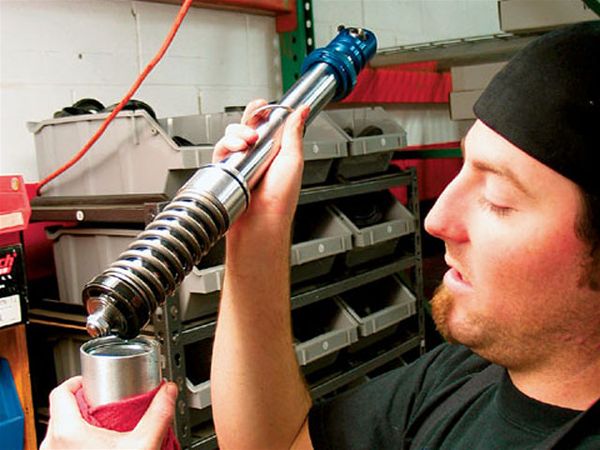
You Need To Be Negative
Fox Racing Shocks has addressed the spring rate issue better than other manufacturers by adding a negative coil spring inside the shock body around the air-shock shaft. This in effect adds some spring rate to the compression stroke of the shock. Plus there are rumors of a 4x4-sized version of Fox's famous mountain-bike Float shock that has an internal damping shock built within the shaft of the air shock, plus a more balanced spring rate, but price may be comparable to a current coilover shock.
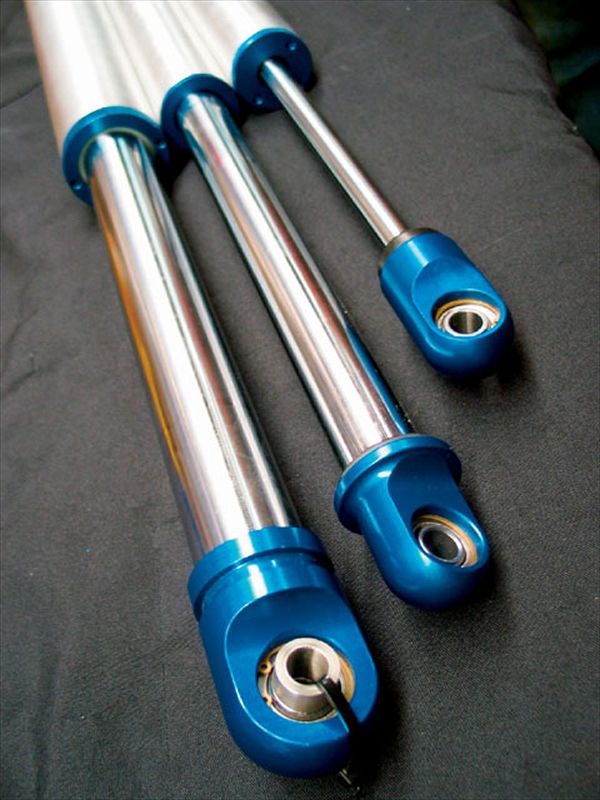
How And Why
The 2- and 2 1/2-inch air shock's shafts are greater than twice the diameter of the basic 2-inch nitrogen-charged damping shock on the right, but the shock bodies on both the 2-inch air shock and the 2-inch damping shock are equal diameter. Thus as the air-shock shaft moves into the shock body it displaces more than four times the volume as the damping shock does and begins compressing the nitrogen charge much like a tire compresses the air within, and that makes it act like a spring. Imagine a plastic cup three-quarters full of water with a lid on it and a small hole in the lid; now if you push a pencil through that hole into the liquid it will only displace a small amount of fluid, and though the pressure may increase slightly it surely won't pop the top off the cup. This is like the damping shock, only it has a piston with holes drilled through it on the end of the shaft (pencil) to slow it down for damping. Now imagine the hole in the cup's top being just big enough to fit a soda can through; it will displace quite a bit more fluid, and even with one-quarter of the cup's volume filled with air it will definitely pop the top off the cup. This is more like an air shock, the larger volume of the can represents the larger shock shaft, but since the top is firmly attached to the shock body the pressure inside will simply increase until it is enough to support the weight of the vehicle.

What's Right 4U?
Most 4x4s running air shocks only use a small amount of uptravel, where usually only 5 inches of uptravel is available with a 16-inch shock. This doesn't really lend itself to high-speed trail bashing. If you take an airshock-equipped vehicle out for some high-speed jaunts, the shocks quickly heat up and begin to raise the ride height of the vehicle. As the oil heats up the nitrogen begins to expand and forces the shaft out of the shock body. Now before you cancel your order for air shocks let's consider your usage. If you have a tube buggy, an old Jeep, or a lightweight Suzuki project and you mainly rockcrawl, rarely see high-speed action over muddy bogs, never plan to do hours of fast wheeling across desert whoops, and you don't drive this thing on the street much, then air shocks are for you. If you choose air shocks you may also want to invest in a sway bar to help deal with the body roll common to them due to the flat spring rate. But if you are looking for big air, ultimate adjustability, and the proper tool for more jobs, then take the step up to coilovers.
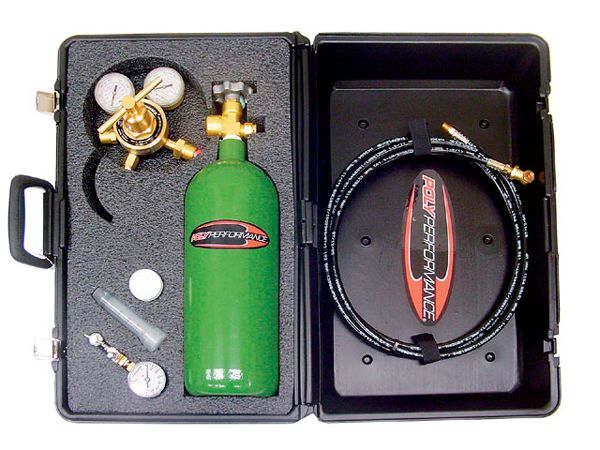
Fill-R-Up
Like coilover shocks, you will need a system to add a high-pressure charge of nitrogen. Poly Performance offers this nitrogen bottle kit for around $400, and it can be filled at most welder shops for $10 to $15.